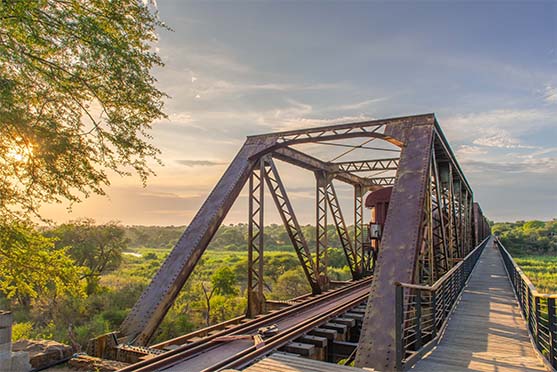
26 Oct Kruger Shalati: Railroad Ties to the Past
ADF MAGAZINE | By Ellen Boonstra
In the wild or sedate world of hospitality and tourism, it is not often that a new venture comes along to remind us of all the things that we love about travel, and how much we have missed it during this year of cabin fever spawned by that killjoy the coronavirus. The lifelong wanderer is on a ceaseless quest for new adventures in magical settings that sit at the crossroads where culture, nature, history and hedonism converge.
The Kruger Shalati Train on a Bridge (a wonderful nutshell description) is just such a first-of-its-kind venture. Overlooking the Sabie River and surrounded by Kruger National Park, this new South African hotel defies superlatives.
From the planning stages to the finishing touches it was a four-year journey for Kruger Shalati Pty Ltd, the trailblazers behind it. Every phase of the project came with its unfair share of hassles and headaches.
“Some of the biggest challenges were the unknowns on the project. No one has ever taken anything like this on in history – so we couldn’t just phone a friend for advice. We had to figure it all out ourselves, from how do we build this, how do we get the train on the bridge, how do we maximize the space, how do we build a walkway on a heritage bridge. Some pieces took a bit longer than we thought it would,” said Judiet Barnes, Executive Manager Brand, Sales and Marketing for Kruger Shalati.
The project brought together a loose alliance of artists to fulfil a demanding brief. For an exterior, the founders wanted an African steampunk vision of safari chic that would appeal to both guests and rail-riding influencers. Inside the 24-room train, the intention was to conjure up an atmosphere of tasteful affluence that reminded guests of the railway’s century-long history while not disturbing the peace of this natural setting with any over-the-top flamboyance.
The Hesse Kleinloog Studio imbued the interiors with a sense of ageless grace. An up-and-coming talent named Bonolo Chepape designed the special blankets in each room to add some threads of Africana to this tapestry. Inspired by the Selati Bridge and the Sabie River below, Sakhile Cebekhulu’s 20-odd artworks enhanced the time-travel effects, whereas Mpho Vackier designed the furniture and Thabisa Mjo supplied some of the lighting designs.
The property’s opening at the end of the catastrophic 2020 could have augured doom, but the naysayers have been silenced. So far, the South African market has responded with a resounding yes to the project. Most weekends are fully booked up. Management believes that once Covid-19 is under control international tourists will pick up the mid-week slack.
What is the optimum length of stay in the hotel?
“I would say three days is the ideal length,” said Judiet. “That really gives you the full experience of the game drives so you don’t feel obliged to do all of them and you can opt to have a lie-in and watch the sunrise from your bed or stay on the train for sunset, which is spectacular in this area. A lot of people prefer to have one day to go for a swim in the overhanging pool and relax. Three days also gives guests a chance to enjoy the great variety of food.”
The backstory of the train hotel embellishes its present-day allure. Almost a century ago, in 1923, South Africa Railways started a train tour cutting through this wilderness that also served as a pioneering game reserve. The tours included an overnight stopover at the bridge, as well as short wildlife-spotting tours and a campfire at night with the soundtrack of a real piano player and the jungle’s pulsating heart. From these small roots sprang both the modern safari and Kruger National Park, one of the world’s greatest wildlife havens and nature reserves. That is a lot of history to imagine and imbibe like an exotic elixir.
Fast forward to the present and what remains the biggest question mark in travel today. Will the “new normal” ever resemble the old normal we once took for granted? This is a quandary that everyone from office workers, stranded at home, to students stuck in cyber limbo and hoteliers in search of guests are pondering with great perplexity. For now, the aftereffects of this global health scare will continue to linger in every sector of society, tourism included.
But what do moneyed travelers really want now?
“The unexpected – people want something unique and different. They want something that encourages social distancing. So nothing too big or too close to people you don’t know. People want vast open spaces. Kruger Shalati is a great example of this because you’re out in the wild where you can do private game drives. People want that ‘Instagram moment.’”
Impeccable service remains crucial but high cleanliness standards are vying with it for supremacy. “Beyond everything it’s your service levels: people want to see that you’re going the extra mile. They want to see safety in terms of COVID protocols being critical. They’d still like to experience but their health and safety comes first,” she added.
Published:
https://www.adfwebmagazine.jp/en/design/kruger-shalati-railroad-ties-to-the-past/



